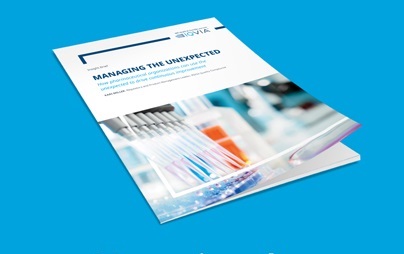Harness the power of automation to execute streamlined end-to-end safety solutions while reducing costs.






















- Blogs
- Managing the Unexpected
Unanticipated, unpredicted, unplanned, unexpected. These words can be undesirable descriptors of many actions or events, but among pharmaceutical quality and compliance professionals, they elicit downright fear.
In this environment, the occurrence of unexpected events signals that something in their organization’s processes or procedures is not completely under control and could possibly have a detrimental impact on product quality and patient safety. For this highly regulated industry, such occurrences not only carry risk, they have regulatory implications.
The FDA’s 21 CFR 211.192, states that any unexplained discrepancy must be investigated, and that the investigation will extend to all batches related to that issue, which can have a huge time and cost impact. EudraLex, The International Council for Harmonization of Technical Requirements for Pharmaceuticals for Human Use (ICH), the World Health Organization (WHO), and other agencies around the globe have similar standards and guidances.
These pressures will only increase as regulatory bodies shift their focus beyond compliance to quality, and more specifically, to the sustainability of quality within pharmaceutical organizations. This means that an organization’s quality system needs to be built around the ability to identify and address the unexpected if they hope to meet regulatory expectations.
But how can a team manage what it doesn’t anticipate? By properly documenting, investigating, and correcting unplanned events. Additionally, it should allow for preventive actions that minimize or eliminate risks of re-occurrence.
MANAGE THE UNEXPECTED
Well trained pharmaceutical quality professionals anticipate the unexpected and have tools and processes in place to manage these events as soon as they occur. When a batch doesn’t come out as expected, a lab result is out of specification, or documented procedures aren’t followed, the team must know exactly what steps to take to record the problem, understand its risk, and investigate accordingly.
That’s why quality professionals rely on tools like Failure Mode and Effects Analysis (FMEA), procedures that detail the steps to take when a problem occurs, corrective and preventive action management processes, and change control.
Common unplanned deviations include, but are not limited to:
- Malfunctioning equipment
- Instrument breakdown
- Utility or service failure
- Human error
- Yield deviation
- Unapproved changes to processes or product ingredients
- Operation outside of defined limits
Managing these quality processes – which ideally integrate with and trigger one another – in manual or disparate systems becomes tricky. Lacking holistic sight lines, it’s difficult to ensure that the right steps are consistently taken to resolve a problem, and consistency is critical to maintaining quality and compliance. Whether you are recording a deviation, an out of specification result, a customer complaint, or other quality event, each must be carried out in a harmonized way to ensure ongoing improvement.
An enterprise Quality Management System (QMS) provides integrated, automated processes to manage, correct, and when possible, prevent the unexpected—smoothly and consistently. The goal of a QMS is to boost quality and efficacy through continuous improvement, thereby increasing patient safety and satisfaction. And harmonized, codified QMS data allows for the delivery of reports and analytics that adequately measure the unexpected, turning that data into actionable information.

PLAY A ROLE IN SETTING THE INDUSTRY’S YARDSTICK
The Center for Drug Evaluation and Research (CDER) has recently begun focusing on pharmaceutical product quality and the effectiveness of manufacturing at the site level.
THE METRICS UNDER REVIEW ARE:
- Lot acceptance rate
- Product quality complaint rate
- Invalidated Out-of-Specification (OOS) rate
- Annual product review
- CAPA effectiveness
- Process capability
This program is in pilot mode, which means there is still time for industry organizations to influence its direction and embrace these measures as part of their own processes. Companies that join the pilot program now will be best positioned when the new measurements are required.
Beyond the implications for compliance, documenting and analyzing the unexpected will serve as a platform for organizational and product improvement, and risk prevention as well.
PREVENT THE UNEXPECTED
Once a quality team can consistently manage and measure the unexpected within their organization, it’s time to move to the next step – prevention and ultimately prediction. While quality teams can’t prevent every defect, they can minimize scrap and wasted batches, improve yield and product compliance, improve overall equipment effectiveness, ensure supply chain safety, and reduce errors. How? By using the data from unexpected events to predict and prevent future problems while identifying opportunities for improvement across the extended enterprise.
By capturing lessons learned from prior events and adapting processes accordingly, enterprise quality management programs can increase efficiency and reduce risk in future operations. But it’s only possible if the quality team and its stakeholders are willing to learn from history and use the unexpected to drive continuous improvement.
To learn more about how IQVIA can assist your company with EQMS systems and continuously improving your quality and compliance, visit us at: iqvia.com/qualitycompliance

Managing the unexpected
Related solutions
Meet the challenge of changing stakeholder demands and increasing cost constraints with IQVIA's integrated technology services and analytics-driven offerings.






